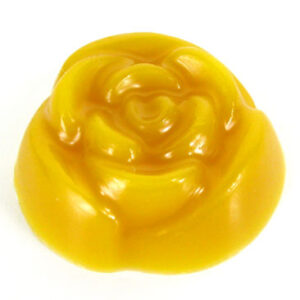Metal Thread Information
METAL HAND EMBROIDERY THREAD INFORMATION
Please find below lots of information and pictures on metal threads and how to use them.
I have a Metal Thread Information PDF File that you can download which has 100 pages with pictures and information on the metal threads that you will find on this webpage.
This PDF is nicely laid out so that you can print off the pages you want and view the enlarged pictures of the threads against the ruler.
I am charging a small fee for the PDF file to cover all the hours that I spent setting up the metal thread information page and the PDF file.
Thank you for supporting my business and purchasing your metal thread requirements and supplies from my website, so I can continue to provide quality hand embroidery information and products,
Best wishes,
Tanja Berlin
What colour metal threads do you sell?
I sell gold 2% WM, gilt, silver and copper in nearly all the threads that I carry.
I also sell other colours such as, red, blue, green, etc, in the Japan threads, passing threads, pearl purls, rough purls and wire check purls. Please visit my products pages to see what I have in stock.
What is the difference between Gold 2% WM and Gilt?
Gold 2% WM is the highest standard gold thread that can be purchased for goldwork. There is 2% gold in the plating covering white metal (WM).
Gilt threads have ½ % of gold in the plating covering copper.
Gold 2% WM is a brighter and truer in colour to real gold. Some gold 2% WM threads are be a bit firmer than the gilt threads.
The gold 2% WM threads and gilt threads that I sell are excellent quality and will tarnish at the same rate.
Can I get pure gold embroidery threads?
I do not have pure gold embroidery threads, I do not think there is a company that makes pure gold threads, as the gold would probably be too soft to be made into embroidery threads and would kink or break. It would also be very expensive.
Will the metal threads tarnish?
Yes the gold 2% WM, gilt, silver and copper embroidery threads will tarnish if exposed to continued spells of direct sunlight and air, because oxides and/or sulfides in the air settle on the surface of the metal thread and cause it to turn dark brown or black over a period of time.
The only threads (that resemble metal threads) that do not tarnish are DMC Metallic Embroidery Thread Light Gold No. 282, Standard Lurex Threads, No. 13 Passing Threads, Japanese Threads, Kreinik Cords and Kreinik #4 Braids, all of which are synthetic threads.
If you are beginning a new piece of embroidery, the best way to decrease tarnishing is to keep the embroidery wrapped in acid-free tissue paper or a sheet and stored in a dark place, such as cupboard when you are not working on the embroidery.
The threads that are being used to work the embroidery should also be stored in the same dark place as the embroidery, in acid-free bags or tissue paper. This is to ensure that that the metal threads will all tarnish at the same rate.
The finished embroidery should be mounted on an acid-free board and displayed behind glass in a box frame so the metal threads are not touching the glass and displayed on a wall without direct sunlight or artificial light so the threads will tarnish at a slower rate.
All real metal threads will eventually tarnish.
Can I clean metal threads?
I do not think there is an effective way to clean the tarnish off metal threads.
If you are beginning a new piece of embroidery then see “Will the metal threads tarnish?” above, on how to decrease the rate of tarnishing.
Can the metal threads be used for garments?
The metal threads that I sell are designed for pictorial design and for very occasional wear such as with re-enactment clothing (traditionally the threads were used for coats of arms, military parade garments and ceremonial garments).
The metal threads are not suitable for mass producing on clothing, as the threads will distort, crack and tarnish when washed or worn on a regular basis.
Can the metal threads be used for making jewelry?
The metal threads are not strong enough to be used for making earrings, necklaces and bracelets unless it is a pendant-style piece of jewelry in which the metal threads are couched down onto a supporting piece of felt or fabric.
Most of the metal threads will tarnish when exposed to direct sunlight or artificial light and the oxides in the air.
You can paint a pendant-style piece of jewelry with a non-yellowing clear varnish to protect the metal threads from tarnishing, as long as there is no fabric that the varnish could stain.
The Kreinik Cords and Kreinik #4 Braids may be suitable for stringing beads and the metal threads can be used for making brooches.
Can the metal threads be used with a sewing machine?
The only threads that I carry that can be used with a sewing machine is the Kreinik gold or silver No. 1 Japan thread or the Kreinik silver and carnival cords all the other metal threads are for hand embroidery.
Do you sell the metal threads wholesale?
I am sorry, I do not sell the metal threads wholesale.
Do you carry a certain metal thread?
All the metal threads that I have in stock are on my website. If you require a different metal thread, please email me and I will see if I can order it from the manufacturer.
Should I use a supporting fabric?
It is a good idea to use a muslin (calico) supporting fabric behind your ground fabric when working goldwork because the embroidery can be dense and cause the fabric to pucker. It also offers more support when taking ends of the metal threads to the back of the work.
How do I calculate the amount of thread required for a project?
This is how I calculate the amount of thread required for a project, although there is a bit of guess work involved.
- Draw or print an outline of your design to the size you want to work the project.
- Decide which thread you want to use in each section of the design. Refer to the Metal Thread Information Page and the Metal Thread Product Pages for the types and sizes of the metal threads.
- Once you have decided on the metal threads, draw lines onto the design, indicating the metal thread that you will be using in each section. Try to draw the lines at the spacing you think the metal thread will take up. I have provided pictures with the metal threads set against a ruler, so you can see how wide the metal thread is and so you have some idea of how many lines of metal thread you will require in a section.
- Take a piece of string and line the string along all the lines for the metal thread section and then measure the piece of string with a measuring tape to see how long a piece of metal thread you will require. If you are working a section in bullion thread, you will have many short lines next to each other. You will have to measure each individual line with the string, or estimate by measuring one short line and counting how many of the same-length short lines you have and multiplying it by the length of the short line.
- Allow extra thread for ends that are taken to the back of the work (check thread, flatworm, Japan, large back, passing thread, rococco, standard lurex thread, twists). Also allow extra for bullion threads, as there is a percentage of wastage when you are cutting the thread to the required lengths.
- I suggest ordering enough metal threads for your entire project because the manufacturing batches of the metal threads can vary in colour and you may not get an exact match the next time you order.
Bullion Thread
Bullions are very fine wire threads wound into a tubular shape, similar to Purl Threads but larger, the making process of the Bullion thread originates in France and was used traditionally for Military uniforms on the epaulets.
One of the main differences between Bullions and Purl Threads is that Bullions come in much larger sizes and if you want to do pictorial work such as the pictures on this page I would suggest using the Purl Threads even if the instructions call for Bullions.
If you want the goldwork to stand out at a distance such as banners or alter frontals and other large needlework projects then the larger Bullion sizes are suitable.
The Bullion threads range in size from No. 1 Bullion being the smallest to No. 10 being the largest. All threads come as a long soft flexible metal tube between 1 inch and 40 inches in length depending on the size, the bigger the size the shorter the length.
The tube is cut up into chips (beads) and couched down onto the fabric – passing the needle and thread through the middle of the chip so the thread is hidden and can be sewn over felt or crochet cotton padding to give the area dimension.
There are three types of Bullion threads:
Bright Bullion
Bright Bullion has a smooth surface and is shiny in appearance (similar to Smooth Purl).



Bright Check Bullion
Bright Check Bullion has a faceted (zig-zag) surface and is shiny (similar to Bright Check Purl).



Wire Bullion
Wire Bullion has a smooth surface and is matte in appearance (similar to Rough Purl).

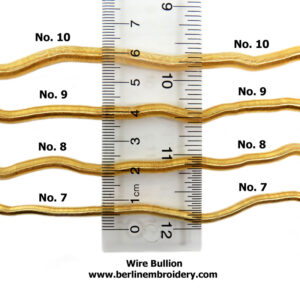
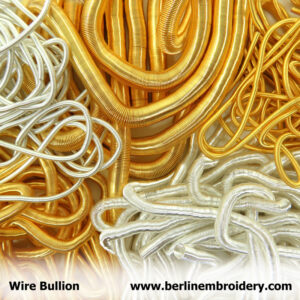
Please see the pictures of Purl Thread further down the page for how Bullion threads can be used in embroideries as the two threads are sewn down in the same method and are very similar in appearance.
Visit the free instructions for the Goldwork Sampler to view pictures on how to sew down Bullion threads (Purl threads) on the Fleur De Lys.
Check Thread
Check is made up of a wire wrapped around a cotton core. The cord has wavy (kinked) serpentine appearance. Check Thread is couched down singularly or two strands at a time in the same colour sewing thread or a contrasting thread. Check Thread is similar to Rococco but much finer and more flexible and has a closer wave so is suitable for filling small areas on a design.




There are three sizes of Check Thread:
- 8 x 2: Approximately 0.5 mm across the width of the thread
- 16 x 3: Approximately 0.75 mm across the width of the thread
- 36 x 6: Approximately 1 mm across the width of the thread
Visit the free instructions for the Goldwork Sampler to view pictures on how to sew down check thread which is the same method as rococco on the leaves of the Heart Design.
Check Thread Pictures

A leaf is worked in check thread over felt padding. A single strand of the check thread is couched down at intervals in the kink of the thread for the length of the leaf. The ends of the thread are taken to the back of the work. The leaf is outlined with pearl purl.

A leaf is worked in check thread over felt padding. A single strand of the check thread is couched down at intervals in the kink of the thread for the length of the leaf. The ends of the thread are taken to the back of the work. The leaf is outlined with pearl purl.

Two leaves are worked in check thread over felt padding. A single strand of the check thread is couched down at intervals in the kink of the thread for the length of the leaf with green thread. The ends of the thread are taken to the back of the work. The leaves are outlined with pearl purl.

Single strands of check thread are sewn down among strands of other metal threads for the mane of a lion. The check thread is sewn down in the kinks of the thread at intervals using a fine metallic thread, the ends of the thread are taken to the back of the work.
Flatworm
Flatworm is made up of a flattened metal strip wound around a fiber core giving it a spongy feel. The thread is then lightly flattened so that the finished appearance is similar to broad plate but is softer and more flexible and therefore easier to handle whilst stitching. The thread is couched down with the same colour or contrasting thread in the same method as plate or passing threads.



- No. 4 Flatworm: Approximately 0.75 mm across the width of the thread
- No. 6 Flatworm: Approximately 1 mm across the width of the thread
Flatworm can be sewn down in two different methods. Visit the free instructions for the Goldwork Sampler to view pictures on how to sew down plate on the Plate Design and passing thread on the Passing Design.
Gimp Cord
Gimp Cord is a large twisted cord great for outlining. The cord consists of three separate strands. Each strand is made up of a fine gold wire wrapped around a thread core. The three strands are twisted together to make the Gimp Cord. The strands can be separated.




I Carry the following sizes in Gimp Cords:
- Gilt Bright Gimp Cord: Approximately 1.5 mm across the width of the thread
- Gold 2% WM Bright Gimp Cord: Approximately 2 mm across the width of the thread
- Gold 2% WM Rough Gimp Cord: Approximately 2 mm across the width of the thread
Visit the free instructions for the Goldwork Sampler to view pictures on how to sew down gimp cord which is the same method as sewing down twist on the Passing Design and Plate Design.
Grecian Twist
Grecian Twists are a two toned twisted cord. The twists alternate between a shiny, serrated surface and a smooth, matt surface.
The Very Fine Grecian Twist also comes as a one toned cord with a smooth, matt surface.
Grecian Twists make a great outlining thread.
The four strands that make up the Grecian Twist are comprised of a fine wire wrapped around a fibre core. The wire is copper based with a gold plating and will tarnish over time.


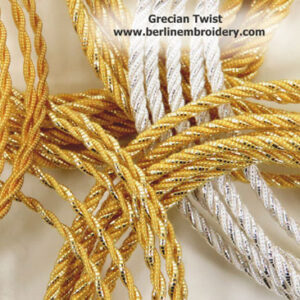

I carry the following sizes in Grecian Twists:
- Gilt Very Fine Grecian Twist: Approximately 1 mm across the width of the thread
- Gilt Fine Grecian Twist: Approximately 1.2 mm across the width of the thread
- Gilt Medium Grecian Twist: Approximately 1.5 mm across the width of the thread
- Gilt Large Grecian Twist: Approximately 2 mm across the width of the thread
Visit the free instructions for the Goldwork Sampler to view pictures on how to sew down Grecian twist which is the same method as sewing down twist on the Passing Design and Plate Design.
Jaceron
Jaceron is the same thread as Pearl Purl in appearance, but the manufacturing process is slightly different. Jaceron is a wire that is wound into a tight coil that looks like a strand of gold pearls. In manufacturing the wire that is wrapped around the needle to create the coil is slightly larger relative to the needle where as in the manufacturing of Pearl Purl the wire is the same size relative to the needle.
Jaceron needs to be stretched before it is used which enables the couching down thread to slip down between the twist of the wire. Tiny stitches are used to sew down the Jaceron at 3 or 4 coil intervals in a thread of the same colour and at the same angle as the twist of the wire so that the thread slips down between the coils and is invisible.
The thread is stiff and easy to manipulate and the end of the thread is cut sheer at the top of the work, rather than taking the end to the back of the work.



No. 4 Jaceron: Approximately 0.75 mm across the width of the thread
If instructions call for Jaceron but I don’t have the size you require, Pearl Purl can be used instead as it is more widely available and the same in appearance.
Please see the pictures of Pearl Purl further down the page for how Jaceron can be applied to embroideries as the two threads are sewn down in the same method and are very similar in appearance.
Visit the free instructions for the Goldwork Sampler to view pictures on how to sew down Jaceron (pearl purl) on the Passing Design and the Heart Design.
Japanese Threads
Japanese threads have a thread core with metal foil wrapped around. The Japanese threads are most commonly used for filling in flat areas on a design in the couching method. The threads come in gold which has a shiny reflective surface or burnished gold which has mat surface and an antique appearance.
Japanese threads are usually couched down two threads at the time (as it fills in the design area faster) and couched down with the same colour sewing thread or a contrasting thread in a bricking fashion. If sewn down with a contrasting thread the Japanese thread can be couched down in a pattern or in a range of shades, this is known as Or nue.
Japanese threads are synthetic thread so will not tarnish.
I carry the following Japanese threads:
Japan Thread – British Burnished
- No. T69: Burnished for an antique look with a matte surface and the highest quality made in the UK. Approximately 0.75 mm across the width of the thread (closest in size to No. 9 (K3) Japan thread).
- No. T70: Burnished for an antique look with a matte surface and the highest quality made in the UK. Approximately 0.5 mm across the width of the thread (close in size to No. 8 (K4) and Kreinik No. 7 Japan thread).
- No. T71: Burnished for an antique look with a matte surface and the highest quality made in the UK. Approximately 0.35 mm across the width of the thread (close in size to Kreinik No. 5 Japan thread).
- No. T72: Burnished for an antique look with a matte surface and the highest quality made in the UK. Approximately 0.25 mm across the width of the thread.
Visit the free instructions for the Goldwork Sampler to view pictures on how to sew down Japanese threads on the heart on the Heart Design.




Japan Thread – British Glossy
- No. 13 (K1): Glossy and shiny and the highest quality made in the UK. Slightly stiffer compared to the Kreinik Japan threads. Approximately 1 mm across the width of the thread.
- No. 12 (K2): Glossy and shiny and the highest quality made in the UK. Slightly stiffer compared to the Kreinik Japan threads. Approximately 0.85 mm across the width of the thread.
- No. 9 (K3): Glossy and shiny and the highest quality made in the UK. Slightly stiffer compared to the Kreinik Japan threads. Approximately 0.70 mm across the width of the thread (close in size to T69 Japan thread).
- No. 8 (K4): Glossy and shiny and the highest quality made in the UK. Slightly stiffer compared to the Kreinik Japan threads. Approximately 0.5 mm across the width of the thread (close in size to T70 and No. 7 Kreinik Japan threads).
Visit the free instructions for the Goldwork Sampler to view pictures on how to sew down Japanese threads on the heart on the Heart Design.



Japan Thread – Kreinik
- Kreinik No. 1 Japan Thread: Approximately 0.2 mm across the width of the thread. Used to couch down metal threads and suitable for machine embroidery and to use in combination with other embroidery threads to add sparkle.
- Kreinik No. 5 Japan Thread: Choice of bright or burnished and made in France. The foil has a slightly looser twist around the thread cored so careful application is required so that the thread core does not become exposed. Approximately 0.35 mm across the width of the thread (close in size to T71 Japan thread)
- Kreinik No. 7 Japan Thread: Choice of bright or burnished and made in France. The foil has a slightly looser twist around the thread cored so careful application is required so that the thread core does not become exposed. Approximately 0.5 mm across the width of the thread (close in size to No. 8 (K4) and T70 Japan threads)
Visit the free instructions for the Goldwork Sampler to view pictures on how to sew down Japanese threads on the heart on the Heart Design
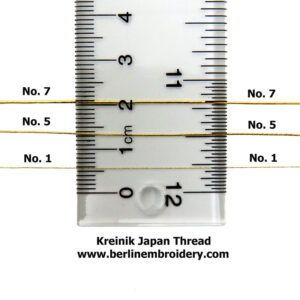


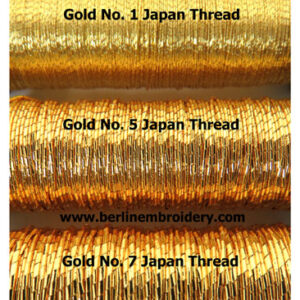
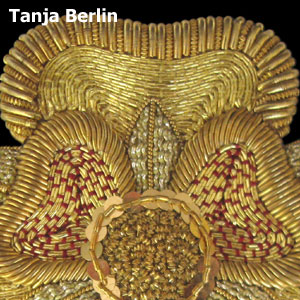
The flat area of the petal at the top of a Goldwork Tudor Rose is worked in Gold No.7 Japan thread. Two strands of the Japan thread are sewn down over felt padding using a polyester sewing thread of the same colour. The Japan gold No. 7 on the flat area of the two smaller petals is sewn down with Red au ver a Soie, Soie D’alger silk thread.

The Goldwork Heart is worked in Gold No. 7 Japan thread. The heart is padded first with lines of crochet cotton and then the Japan thread is sewn over the padding at intervals, two strands at a tine to create a pattern in the heart shape. The ends of the Japan thread are taken to the back of the work. The heart is outline with a red silk cord.

The scales on a pineapple are worked by sewing down a single strand of Japanese thread over felt padding. The scales at the center of the pineapple are worked in No. 8 (K4) Japanese thread and the scales on the edge of the pineapple are worked in a single strand of Gold T70 Japan thread, sewn down with polyester sewing thread.

The flower head of the Goldwork Tulip is worked in Or Nue which is the couching down of one strand of Kreinik burnished gold No. 7 Japan at the time with different shades of red Au ver a Soie, Soie D’alger silk thread to create a shaded and dimensional flower. The petals are outline in pearl purl.
Large Back
Large Back is made up of fine wire wrapped around a cotton core. The thread is shiny and glossy, rounded and smooth in appearance and makes a great outlining thread.
Large Back is couched down singularly in the same colour sewing thread or a contrasting colour and the ends are taken to the back of the work.
The thread measures approximately 1.25 mm across the width of the thread.

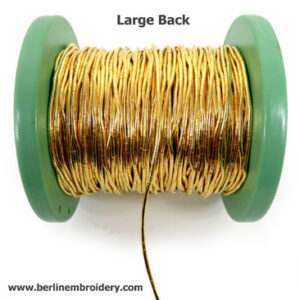
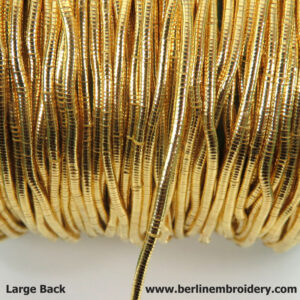
Lizerine
Lizerine is very similar in appearance to Pearl Purl and Jaceron, but the thread is squarer, flatter, stiffer and glossier. The thread is a wire that is wound into a tight coil that looks like a strand of squared gold pearls due to the slightly flattened appearance.
Lizerine needs to be stretched before it is used which enables the couching down thread to slip down between the twist of the wire. Tiny stitches are used to sew down the Lizerine at 3 or 4 coil intervals in a thread of the same colour and at the same angle as the twist of the wire so that the thread slips down between the coils and is invisible.
The thread is stiff and easy to manipulate and the end of the thread is cut sheer at the top of the work, rather than taking the end to the back of the work.

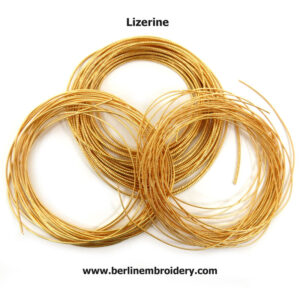

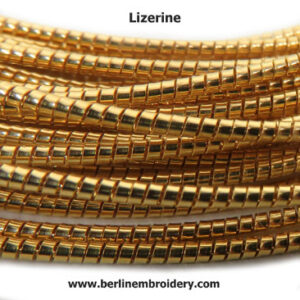
I carry the following sizes in Lizerine:
- Very Fine Lizerine: Approximately 0.5 mm across the width of the thread
- Super Lizerine: Approximately 0.75 mm across the width of the thread
- No. 1 Lizerine: Approximately 0.90 mm across the width of the thread
Please see the pictures of Pearl Purl further down the page for how Lizerine can be applied to embroideries as the two threads are sewn down in the same method and are very similar in appearance.
Visit the free instructions for the Goldwork Sampler to view pictures on how to sew down lizerine (pearl purl) on the Passing Design and the Heart Design.
Milliary Wire
Milliary wire is a two part thread, consisting of a central core wire, with a coiled wire around it. The Milliary wire is couched down in a thread of the same colour so that the stitches are not visible. Milliary wire is most appropriate as an outlining thread and is very interesting to look at.
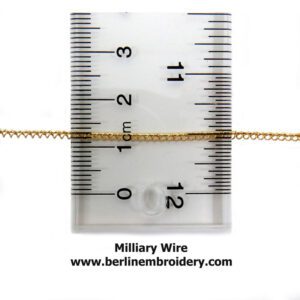



Milliary Wire: Approximately 2 mm across the width of the thread
Visit the free instructions for the Goldwork Sampler to view pictures on how to sew down Milliary Wire on the plate design.
Milliary Wire Pictures
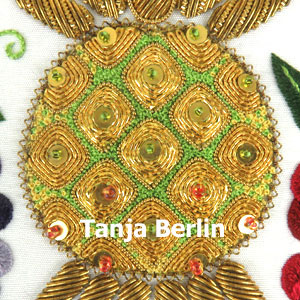
The body of the pineapple on the Goldwork Still-Life embroidery is outlined in Milliary wire.

Sections of the Goldwork Sampler plate design are outlined with Milliary wire.
Passing Threads
Passing thread is made up of a fine wire tightly wrapped around a thread core. The thread is straight and smooth in appearance, similar to Japanese thread but finer and easier to apply especially when turning the thread back and forth on a design.
The No. 13 Passing threads are synthetic threads so will not tarnish and are the same size as No. 7 Smooth Passing. All the smooth passing threads are real metal threads and will tarnish over time.
Check out Standard Lurex Thread for a non-tarnishing thread, similar in size to No. 4 Smooth Passing.
Passing threads are usually couched down two threads at the time (as it fills in the design area faster) and couched down with the same colour sewing thread or a contrasting thread in a bricking fashion. If sewn down with a contrasting thread the passing thread can be couched down in a pattern or in a range of shades, this is known as Or nue.




I carry the following sizes in Passing Threads:
- No. 3 Smooth Passing Thread: Approximately 0.25 mm across the width of the thread – best passing thread for underside couching
- No. 4 Smooth Passing Thread: Approximately 0.35 mm across the width of the thread
- No. 5 Smooth Passing Thread: Approximately 0.5 mm across the width of the thread
- No. 6 Smooth Passing Thread: Approximately 0.7 mm across the width of the thread
- No. 7 Smooth Passing Thread: Approximately 0.8 mm across the width of the thread
- No. 13 Passing thread: Approximately 0.8 mm across the width of the thread. The No. 13 Passing is a synthetic thread so will not tarnish
Visit the free instructions for the Goldwork Sampler to view pictures on how to sew down passing thread on the scroll of the passing Design.
Passing Thread Pictures

The crown and wattle of a rooster is worked in No. 5 smooth passing over felt padding. The passing thread is couched down singularly with a single strand of red Au ver a Soie, Soie D’alger silk thread.
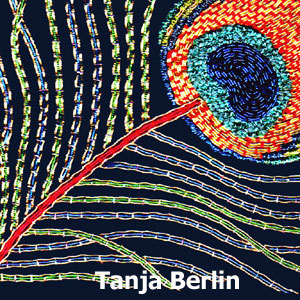
The fine feather fronds on a peacock feather are worked in 2 strands of green, blue and red No. 13 passing thread. The passing thread is couched down with a fine metallic thread. The center of the peacock feather eye is worked in blue No. 13 passing thread.

The scroll of the Goldwork Passing Design is worked by couching down two strands of the No. 5 smooth passing thread at the same time in a similar colour polyester sewing thread and outlined with pearl purl.

A Dragonfly is worked in or nue by couching down one strand of silver No. 6 passing thread with a variegated silk thread for the background and coloured metallic threads for the dragonfly.
Pearl Purl
Pearl Purl is the same thread as Jaceron in appearance and very similar to Lizerine and can be used instead of either thread.
Pearl Purl is a wire that is wound into a tight coil that looks like a strand of gold pearls.
Pearl Purl needs to be stretched before it is used which enables the couching down thread to slip down between the twist of the wire. Tiny stitches are used to sew down the pearl purl at 3 or 4 coil intervals in a thread of the same colour and at the same angle as the twist of the wire so that the thread slips down between the coils and is invisible.
The thread is stiff and easy to manipulate and the end of the thread is cut sheer at the top of the work, rather than taking the end to the back of the work.
Pearl Purls threads are used as outlines for designs or as a filling and can be combined with other threads for interesting effects.




I carry the following sizes in Pearl Purl:
- Very Fine Pearl Purl: Approximately 0.6 mm across the width of the thread
- Super Pearl Purl: Approximately 0.75 mm across the width of the thread – Equivalent in size to No. 4 Jaceron
- No. 1 Pearl Purl: Approximately 0.90 mm across the width of the thread – Equivalent in size to No. 7 Jaceron
- No. 2 Pearl Purl: Approximately 1.1 cm across the width of the thread
- No. 3 Pearl Purl: Approximately 1.25 cm across the width of the thread
- Coloured No. 2 Pearl Purls: Vary in size – Approximately 1.25 cm – 1.75 across the width of the thread depending on colour
Visit the free instructions for the Goldwork Sampler to view pictures on how to sew down pearl purl on the Passing Design and the Heart Design.
Pearl Purl Pictures

The petals of a tulip are outlined with super pearl purl.

The crown, beak and wattle of a rooster are outlined with very fine pearl purl. The face is outlined with super pearl purl.

The scroll of the Goldwork Passing Design is outlined with super pearl purl.

The wings of a blackwork butterfly are outlined with very fine pearl purl.
Pearl Purl Pictures
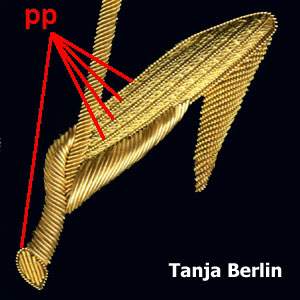
Lines of super pearl purl are sewn down between two lines of No. 1 twist. The leaf and bottom of the stem is outlined with super purl.

A leaf has a line of No. 2 pearl purl for the vein and is outlined in super pearl purl.

Brooch worked in lines of coloured No. 2 pearl purl. Some of the lines of pearl purl have been over stretched for a different effect.

Pearl purl is couched down with small stitches worked at a diagonal that are hidden in the twist of the metal coil.
Plates
There are two types of metal Plates:
- Broad Plate is a broad flat strip of shiny metal. The plate is laid by folding the plate back and fourth across a shape, the turn of the plate is on the edge of the shape (the shape should be simple with a smooth edge). The couching down stitches are hidden in the turn of the plate. The plate can also be sewn down by couching a purl (chip) bead over the plate to anchor it or using a coloured couching thread and sewing down the plate in a straight line. The end of the plate is cut sheer or folded in rather than taking the end to the back of the work.
- Whipped Plate is a broad flat shiny metal plate with a wire wrapped around the plate at an angle creating a serrated appearance. The whipped plate is couched down in the same method as the broad plate.




I carry the following sizes in Plates:
- No. 11 Broad Plate: Approximately 1mm across the width of the thread
- No. 6 Broad Plate: Approximately 1.5mm across the width of the thread
- Whipped Plate: Approximately 1.5mm across the width of the thread
Visit the free instructions for the Goldwork Sampler to view pictures on how to sew down plate on the Plate Design.
Plate Pictures

The head of acorns are worked in No. 6 broad plate.

Two sections of No. 6 broad plate are worked in the middle of the shape.
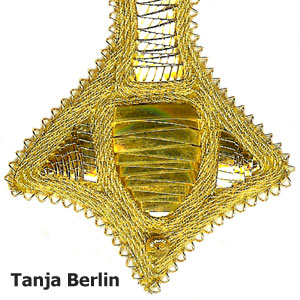
The top center section and the two small triangle sections at the sides are worked in whipped plate. The bottom center section is worked in No. 6 broad plate.
Purl Threads
Purl Threads, also known as Bullions and Frieze (French term) are made up of a very fine wire thread that is wound into a soft flexible hollow tube. The tube is cut up into chips (beads) and couched down onto the fabric – passing the needle and thread through the middle of the chip so the thread is hidden and can be sewn over felt or crochet cotton padding to give the area dimension.
The Purl Threads are very similar to Bullions but are finer. I use the purl threads for my Goldwork Embroidery Kits as I find that the Bullions are too thick. For large goldwork embroidery projects you can use the Bullion threads as they cover more of the fabric.
The Purl Threads range in size from No. 10 being the smallest to No. 4 being the largest which is the opposite method of sizing to the Bullion threads. The thread typically comes in two or three lengths to make up one yard.
There are four types of Purl Threads:
Bright Check Purl
Bright Check Purl has a faceted (zig-zag) surface and is shiny in appearance.
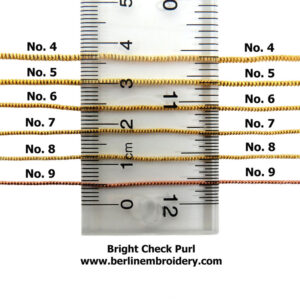



Rough Purl
Rough Purl has a smooth surface and is matte in appearance – comes in a variety of colours.

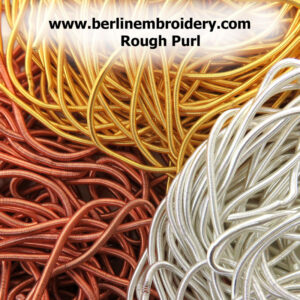


Smooth Purl
Smooth Purl has a smooth surface and is shiny in appearance.
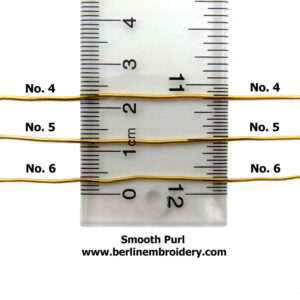
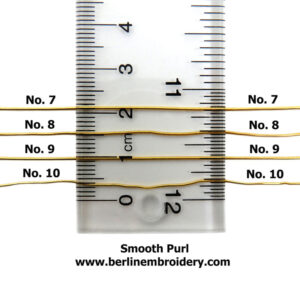
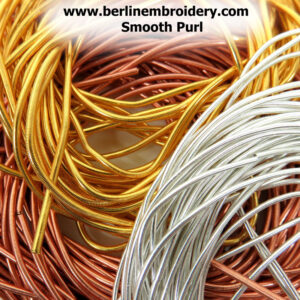

Wire Check Purl
Wire Check Purl has a faceted (zig-zag) surface and is matte in appearance – comes in a variety of colours.

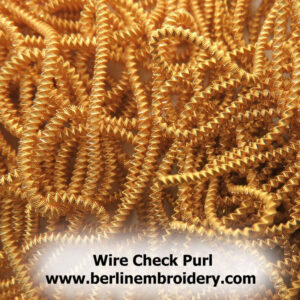


Visit the free instructions for the Goldwork Sampler to view pictures on how to sew down purl threads on the Fleur De Lys design.


Purl Thread Pictures

A leaf is worked in rough purl (wire bullion) for the main body of the leaf and smooth purl (bright bullion) on the tip of the leaf over felt padding. The purl or bullion threads are cut to the length required to cover the felt

A leaf is worked in rough purl (wire bullion) for the lower portion of the leaf and wire check purl for the upper part of the leaf. The s-ing vein down the center of the leaf is worked in smooth purl (bright bullion).

A leaf Is worked alternating between one wire check purl chip and two smooth purl chips (bright bullion chips) over felt padding. The s-ing vein line down the center of the leaf is worked in rough purl (wire bullion).

A rams horn is worked in four sections. A variety of purl threads are sewn down over crochet cotton padding on the four sections to create a dimensional, shaded horn.
Purl Thread Pictures

The top of the Fleur de Lys is worked in smooth purl (bright bullion) over crochet cotton padding. In-between the gold long and short stitch is worked in red Au ver a Soie, Soie D’alger silk thread.

The scroll of the Fleur De Lys is worked in smooth purl (bright bullion) over crochet cotton padding. Note the angle changes of the purl thread on the scroll.

The bottom center part of the Fleur De Lys is worked in bright check purl (bright check bullion) over crochet cotton padding. The side scrolls are worked in rough purl (wire bullion) over crochet cotton padding.

The center of a flower is worked in bright check purl (bright check bullion) sewn over felt padding.The chips (beads) are sewn down randomly, in different directions covering the entire surface of the felt.
Purl Thread Pictures

The mane of a lion is worked in gold and copper bright check purl and smooth purl in s-sing.

The top feathers of the Phoenix wing are worked in gold and copper bright check purl chips the bottom feathers are worked in smooth purl chips.

Turquoise wire check purl chips are couched down randomly around the dark blue center of the peacock feather eye.
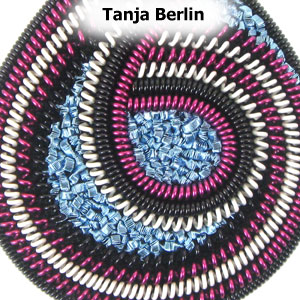
Sections of blue wire check purl chips are sewn down randomly in-between lines of pearl purl.
Rococco
Rococco is made up of a wire wrapped around a cotton core. The cord has wavy (kinked) serpentine appearance and is thicker and stiffer and has a more open wave than Check Thread. Rococco is couched down singularly in the same colour sewing thread or a contrasting thread.
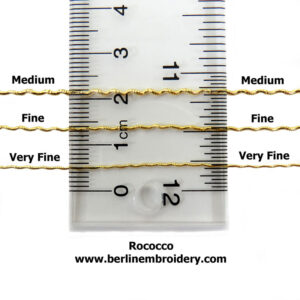



There carry three sizes of Rococco:
- Very Fine Rococco: Approximately 0.75 mm across the width of the thread
- Fine Rococco: Approximately 1 mm across the width of the thread
- Medium Rococco: Approximately 1.5 mm across the width of the thread
Visit the free instructions for the Goldwork Sampler to view pictures on how to sew down the rococco on the leaves of the Heart Design.
Rococco Pictures

Leaves on the Goldwork Heart Design are worked in fine rococco which is sewn down singularly over felt padding using a single strand of polyester sewing thread.

The head of the Goldwork Or Nue Peacock Feather is worked in very fine rococco which is sewn down two strands at a time using red silk thread or Kreinik metallic threads.

Lines of medium rococco are sewn down between lines of No. 1 1/2 twist or lines of stem stitch in green silk thread.

Single strands of rococco are sewn down among strands of other metal threads for the tail feathers of a Phoenix.
Spangles – Paillettes
Spangles are also known as Paillettes (French term) are hard metal disk with a hole in the center, similar to a sequin but superior in quality. Spangles are made by twisting a metal wire around a metal rod, forming metal rings that are cut off and hammered flat leaving a fine seam along one side of the spangle and a hole in the center of the spangle through which you sew down the spangle with one or more stitches or a french knot or bead to hold the spangle in place.



I carry several sizes in Spangles – Paillettes:
- #6: Approximately 1/4 of an inch (6.5 mm) across the width of the spangle and approximately 16 spangles in 1 gram
- #7: Approximately 7/32 of an inch (5 mm) across the width of the spangle and approximately 20 spangles in 1 gram
- #9: Approximately 5/32 of an inch (4.5 mm) across the width of the spangle and approximately 26 spangles in 1 gram
- #12: Approximately 1/8th of an inch (3.5 mm) across the width of the spangle and approximately 48 spangles in 1 gram
- #14: Approximately 3/32 of an inch (3 mm) across the width of the spangle and approximately 69 spangles in 1 gram
Visit the free instructions for the Goldwork Sampler to view pictures on how to sew down the spangles on the Passing Design and the Plate Design.
Spangles – Paillettes Pictures

A leaf is worked in rough purl with a spangle threaded on the end of every third purl.

Spangles are sewn down on the Goldwork Sampler Plate design with a purl chip at center of the spangle.

The ground underneath the Goldwork Tulip is decorated with spangles.

The top edge of the two top wing feathers have a spangle at the end of each check purl chip.
Standard Lurex Threads
Lurex threads are made up of a fine synthetic wire tightly wrapped around a thread core. The thread is straight and smooth in appearance and similar in appearance and size to No. 4 Smooth Passing Thread.
Lurex threads do not tarnish but have the appearance of a real metal thread.
Lurex threads are usually couched down two threads at the time (as it fills in the design area faster) and couched down with the same colour sewing thread or a contrasting thread in a bricking fashion. If sewn down with a contrasting thread the lurex thread can be couched down in a pattern or in a range of shades, this is known as Or nue.
The thread is soft and easy to use and is great for the plaited braid stitch.




Standard Lurex Thread is approximately 0.35 mm across the width of the thread.
Please see the pictures for the Passing Thread for how lurex thread can be applied to embroideries.
Visit the free instructions for the Goldwork Sampler to view pictures on how to sew down lurex thread (passing thread) on the scroll of the passing design.
Tambour
Tambour thread is fine real metal thread that can be used for couching down other metal threads such as Passing Thread, Rococco, Check thread, Standard Lurex Thread, Large Back and Japan thread. The thread is made of a fine metal wire wrapped around a fine thread core. The thread will tarnish over time.
If you want an alternative thread that will not tarnish then you can use No. 1 Japan Thread or the Kreinik Cords.



Tambour Thread is approximately 0.2 mm across the width of the thread.
Twists
Twists (Torsade) are twisted cords. The cords are made up of three separate strands that are twisted into a cord. Each strand is made up of a wire wrapped around a thread core. The twists are couched down by sewing the stitch at the same angle as the twist of the cord, into the middle of the cord so that the stitch is invisible using a similar colour polyester sewing thread.


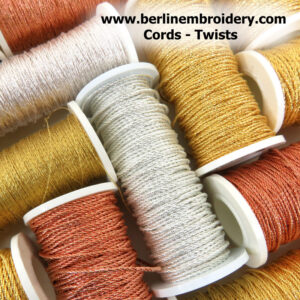

I carry the following sizes in Twists:
- Elizabethan Twist: Approximately 0.25 mm across the width of the thread
- Super Twist: Approximately 0.35 mm across the width of the thread
- No. 1 Twist: Approximately 0.5 mm across the width of the thread
- No. 1 ½ Twist: Approximately 0.7 mm across the width of the thread
- No. 2 Twist: Approximately 0.8 mm across the width of the thread
- No. 3 Twist: Approximately 0.9 mm across the width of the thread
- No. 4 Twist: Approximately 1 mm across the width of the thread
- No. 6 Twist: Approximately 1.2 mm across the width of the thread
Visit the free instructions for the Goldwork Sampler to view pictures on how to sew down twist on the Passing Design and Plate Design.
Twists Pictures

The red tear drop shapes on the Passing Design are outlined in No. 1 Twist.

No. 1 Twist is couched down around the plate shapes on the triangle shape at the bottom of the Plate Design.

The leaf is worked by sewing down two strands of Elizabethan twists, using green thread and sewing the stitches on the vein line and edge of the leaf only.

The leaf is worked by sewing down lines of No. 1 Twist with lines of green stem stitch in-between.
Suggested Tools and Supplies for Working Metal Thread Embroidery
Following are tools and supplies that I recommend for working metal thread embroidery. If you are working one of my kits, the felt, crochet cotton and polyester sewing thread comes in the kit. The tools you purchase separately.
I carry many more goldwork tools and supplies on my website that would be useful but the following are the ones that I use the most when I work a goldwork design.
- Goldwork Scissors: Small, sharp scissors for cutting metal threads.
- Fine Tipped Tweezers: For positioning and manipulating metal threads.
- Mellor: A especially made goldwork tool used to push metal threads in position. Less abrasive than other tools so less likely to damage the metal threads.
- Goldwork and Beading Pad: A soft velux pad for cutting purl threads on.
- Beeswax: For waxing polyester sewing thread when sewing down Bullions, Gimp Cord, Grecian Twist, Jaceron, Lizerine, Pearl Purl, Purl Threads and Twists.
- Stretcher Bar Frame: Appropriate size stretcher bar frame for the design. Keeps the fabric tight and does not mark the fabric near the design like hoops can (ring frames).
- Felt: For padding areas of the design.
- Crochet Cotton: For padding areas of the design.
- Polyester Sewing Thread: For sewing down metal threads. I recommend using polyester sewing thread to sew down Bullions, Gimp Cord, Grecian Twist, Jaceron, Lizerine, Pearl Purl, Purl Threads and Twists as you require a strong thread to sew down these metal threads. For the other metal threads you can use a matching colour polyester sewing thread or silk thread such as Au ver a Soie, Soie D’alger silk thread.
- Needles: I recommend size 10 crewel embroidery needles for sewing down padding and most of the metal threads. Size 12 crewel embroidery needles or No. 12 short/sharp beading needles for sewing down fine purl threads sizes, 7, 8, 9 and 10 and No. 18 chenille needle for taking the ends of the strands of couched metal threads to the back of the work.
If you have any questions about the metal threads and tools please feel free to email me: [email protected]






